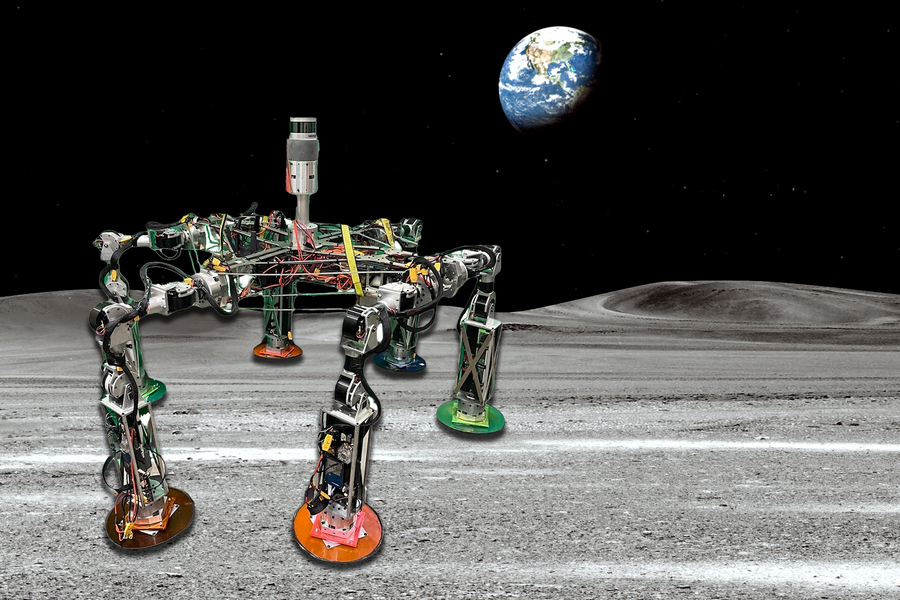ロボットのパーツを組み立てて、溶岩洞窟を探索する軽快なスパイダーボットや、ソーラーパネルを運搬する頑丈なエレファントボットを作ることができる。 Robotic parts could be assembled into nimble spider bots for exploring lava tubes or heavy-duty elephant bots for transporting solar panels.
2023-03-14 マサチューセッツ工科大学(MIT)
Walking Oligomeric Robotic Mobility System(WORMS)と呼ばれるこのシステムは、シャーシにはめ込むことができるワームのようなロボットの手足で構成されています。このパーツは、生息地の建設やケーブルの敷設など、さまざまな作業を行うために、さまざまなタイプの機械に組み替えることができる。ミッションが終了すると、ロボットは分解され、部品は新しいマシンを構成するために使用されます。
チームはすでに、6本足のWORMSロボットを製作し、デモンストレーションを行っています。
<関連情報>
- https://news.mit.edu/2023/mixed-robot-kit-lunar-exploration-0314
- https://www.researchgate.net/publication/369020177_WORMS_Field-Reconfigurable_Robots_for_Extreme_Lunar_Terrain
WORMS:月の過酷な地形に対応するフィールドリコンフィギュラブルロボット WORMS: Field-Reconfigurable Robots for Extreme Lunar Terrain
George Lordos,Michael J. Brown,Kir Latyshev,Aileen Liao,Sharmi Shah,Cesar Meza,Brooke Bensche,Cynthia Cao,Yang Chen,Alex S Miller,Aditya Mehrotra,Jacob D. Rodriguez,Anna Mokkapati,Tomas Cantu,Katherina Sapozhnikov,Jessica Rutledge,David Trumper,Sangbae Kim,Olivier Ladislas de Weck,Jeffrey Hoffman,Wendell Chun
March 2023 Conference: IEEE Aerospace 2023 At: Big Sky, Montana

Abstract and Figures
The 2022 NASA BIG Idea Challenge invited teams to develop novel extreme lunar terrain mobility technologies in support of the Artemis program, setting only the constraint to not propose a wheeled robot. This paper proposes a platform for field-reconfigurable walking robots that can be tailored to multiple missions and even repaired in the field. Design exploration started with listing potential missions for walking robots, and took inspiration from animals to conceptualize four different locomotion strategies and associated novel robot forms. We then synthesized all ideas into our field-reconfigurable robot platform architecture, the Walking Oligomeric Robotic Mobility System (WORMS). The elements of WORMS include identical articulating Worm robots, simple Accessories, such as shoes and chassis or pallets, as well as more sophisticated Species Modules (such as the ‘Mapper’). With a variety of elements in hand, different animal-like robots can be rapidly assembled and dispatched to support many different mission profiles. Specialization of function is accomplished using a variety of modular Accessories and Species Modules, such as different shoes, an anchoring drill, or a winch-and-cable. Each known robot configuration requires only the needed hardware elements plus software, meaning that new robots can be transmitted to the Moon. The system is designed for ease of assembly, operations and maintenance by non-specialists. In our WORMS-1 proof of concept which is presented here, six Worms with large Apollo-like shoes serve as legs to traverse high-porosity and steeply inclined terrain in order to set up a charging and radio relay station for other rovers inside permanently shadowed regions. Different robot configurations, working alone or in swarms, could traverse other terrain types and perform different missions. WORMS is enabled by three key technologies: (1) the Worm robot itself; (2) the universal interface block (UIB) which is a common mating adapter for all mechanical, electrical and data connections between Worms, Accessories and Species Modules and (3) the ability to safely share electrical power between Worms. In the paper, we present the architecture, trade studies, test results and path-to-flight considerations to evolve the as-built proof of concept WORMS-1 from its current Technology Readiness Level (TRL) 4 into a future TRL 6 design. We also describe the methods and lessons learned from our step-by-step architecting process, which included brainstorming, concept generation and concept fusion into a versatile platform design. We propose that WORMS is a resilient, easily main-tainable, low-cost, evolvable, flexible, future-proof and modular architecture for the rapid field assembly of robots to support extreme terrain access and lunar infrastructure development. WORMS can therefore support many of the needs of NASA and its commercial and industrial partners throughout the Artemis program and on to Mars and beyond.



